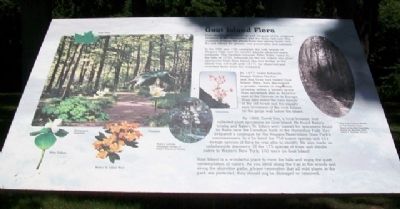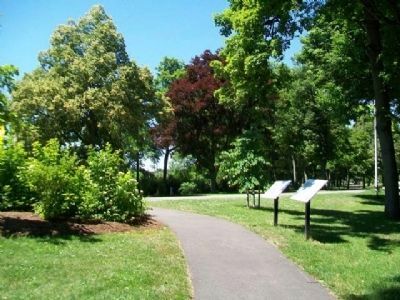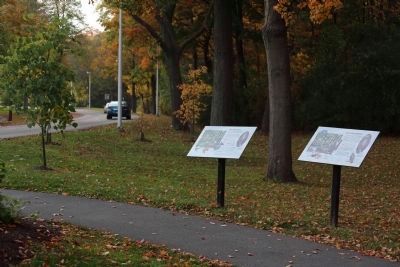Niagara Falls in Niagara County, New York — The American Northeast (Mid-Atlantic)
Goat Island Flora
Goat Island's plants grow so well because of the constant moisture in the atmosphere and the deep, rich soil. the moisture protects the plants from late spring frosts, and the soil allows for greater root penetration and nutrition.
In the 18th and 19th centuries, the lush beauty of Niagara Falls and the nearby islands attracted many botanists. The Swedish botanist, Peter Kalm, came to the falls in 1750. Although he did not collect any plant specimens from Goat Island (the first bridge to the island was not built until 1817), he observed and recorded them from the mainland.
By 1877, noted botanists Joseph Dalton Hooker and Asa Gray had visited Goat Island. Here, they discovered a greater variety of vegetation growing within a limited space than anywhere else in America east of the Sierras, or in Europe. They also noted the rare beauty of the old forest and the equally rare loveliness of the rock foliage on the gorge wall below the island.
By 1888, David Day, a local botanist, had collected plant specimens on Goat Island. He found Kalm's lobelia and Kalm's St. John's wort, named for specimens found by Kalm near the Canadian flank of the Horseshoe Falls. Day prepared a catalogue for the Niagara Reservation State Park's commissioners. In it he listed the 758 native species and 151 foreign species of flora he was able to identify. He also made an unbelievable discovery. Of the 175 species of trees and shrubs native to Western New York, 140 were on Goat Island!
Goat Island is a wonderful place to view the falls and enjoy the quiet contemplation of nature. As you stroll along the trail in the woods and along the shoreline paths, please remember that all wild plants in the park are protected; they should not be damaged or removed.
[Photo caption of plants on marker]
Sugar Maple • Dutchman's Breeches • White Trillium • Kalm's St. John's Wort • Mayapple • Kalm's Lobelia • Columbine
[Upper right photo caption reads]
View in the Primeval Woods, on Goat Island from the Report of the New York State Survey for the Year 1879. James T. Gardiner, Director.
Erected by Niagara Falls State Park.
Topics. This historical marker is listed in these topic lists: Environment • Waterways & Vessels. A significant historical year for this entry is 1750.
Location. 43° 4.773′ N, 79° 3.945′ W. Marker is in Niagara Falls, New York, in Niagara County. Marker is at the intersection of Goat Island Road and Three Sisters Islands Parking Area, on the left when traveling west on Goat Island Road. Marker is on Goat Island, part of Niagara Falls State Park. Touch for map. Marker is in this post office area: Niagara Falls NY 14303, United States of America. Touch for directions.
Other nearby markers.
At least 8 other markers are within walking distance of this marker. Three Sisters Islands (here, next to this marker); The Niagara Portage (approx. ¼ mile away); The Parting of the Waters (approx. ¼ mile away); Cave of the Winds and Bridal Veil Falls (approx. ¼ mile away); The Cave of the Winds (approx. ¼ mile away); The Power of the American Rapids (approx. 0.3 miles away); Niagara River Corridor Important Bird Area (approx. 0.3 miles away); World's First Hydroelectric Power Plant (approx. 0.3 miles away). Touch for a list and map of all markers in Niagara Falls.
Also see . . .
1. History of America's Oldest State Park. (Submitted on August 4, 2014, by William Fischer, Jr. of Scranton, Pennsylvania.)
2. Botanical Evaluation of the Goat Island Complex. (Submitted on August 4, 2014, by William Fischer, Jr. of Scranton, Pennsylvania.)
Credits. This page was last revised on June 16, 2016. It was originally submitted on August 4, 2014, by William Fischer, Jr. of Scranton, Pennsylvania. This page has been viewed 436 times since then and 22 times this year. Photos: 1, 2. submitted on August 4, 2014, by William Fischer, Jr. of Scranton, Pennsylvania. 3. submitted on November 20, 2014, by J. J. Prats of Powell, Ohio.


